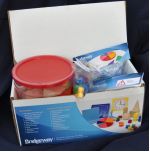Discovery Math kits provide hands-on learning activities that will coordinate with many math programs, although the publisher has written guides showing correlations to math programs from BJU Press, Singapore Math, Horizons Math, Saxon, A.C.E., and Scott Foresman. One manipulatives kit can be used over four years with the two companion Kit Guides, one guide for Grades K-1 and the other for Grades K-2.
The manipulatives kit includes teddy bear counters, Unifix cubes, pattern blocks, Base Ten Blocks/Place Value Blocks, fraction circles, a clock, colored counters, a geoboard, and 3-D solid shapes.
The Kit Guides each have a multi-page chart with more than 30 activities that are appropriate for their respective grade levels. The charts identify the math concept taught, the grade level(s) at which they are taught, suggested materials, and activity descriptions. In addition to the resources from the manipulatives kit you will need to use a few “household” items such as a paper bag, index cards, a die, a jump rope, an egg carton, and construction paper.
In many cases the descriptions in the charts are sufficient explanation. However, for some activities there are visual aids, expanded explanations, and activity sheets. In addition, each book has a few pages that you might reproduce and use frequently such as a hundreds chart, graph paper, geoboard grids, and a place value chart.
While Discovery Math offers wonderful hands-on learning lessons, some parents will have trouble figuring out when to use them. So Bridgeway Academy created companion Correlation Guides that show how you can use the activities with the aforementioned publishers’ programs. (I’m not sure why Saxon Math is included since the courses for the younger levels have their own manipulative sets that are designed for the program.) The Correlation Guides are available for free upon request.
Correlation Guides have a section for each publisher with charts arranged in the order of the activities as they are presented in Discovery Math. Charts list the chapter, lesson, or page number for the corresponding lessons in each text for each grade level. Many times, an activity will correspond to a number of lessons.
If you use a program not covered by the Correlation Guides, it shouldn’t be that difficult to come up with your own correlation, although you will need to dedicate some time to doing so before the school year begins.
Even with the Correlation Guides, parents need to do a little advance preparation so that they know how to present each activity. However, activities are simple enough that this is not going to require a lot of time.
Discovery Math is a great solution for situations where you’ve already purchased a math program without manipulatives, yet you find that your child really needs more hands-on learning. Rather than dumping the first program and investing in a new program that includes manipulatives, let Discovery Math fill the gap.








